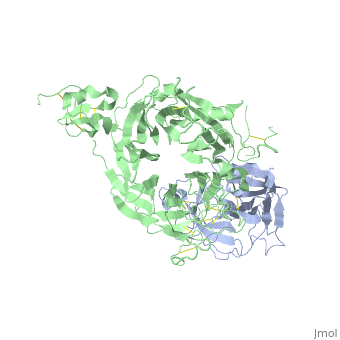1shy
From Proteopedia
(New page: 200px<br /> <applet load="1shy" size="450" color="white" frame="true" align="right" spinBox="true" caption="1shy, resolution 3.22Å" /> '''The Crystal Structu...) |
|||
| Line 1: | Line 1: | ||
| - | [[Image:1shy.gif|left|200px]]<br /> | + | [[Image:1shy.gif|left|200px]]<br /><applet load="1shy" size="350" color="white" frame="true" align="right" spinBox="true" |
| - | <applet load="1shy" size=" | + | |
caption="1shy, resolution 3.22Å" /> | caption="1shy, resolution 3.22Å" /> | ||
'''The Crystal Structure of HGF beta-chain in Complex with the Sema Domain of the Met Receptor.'''<br /> | '''The Crystal Structure of HGF beta-chain in Complex with the Sema Domain of the Met Receptor.'''<br /> | ||
==Overview== | ==Overview== | ||
| - | The Met tyrosine kinase receptor and its ligand, hepatocyte growth factor | + | The Met tyrosine kinase receptor and its ligand, hepatocyte growth factor (HGF), play important roles in normal development and in tumor growth and metastasis. HGF-dependent signaling requires proteolysis from an inactive single-chain precursor into an active alpha/beta-heterodimer. We show that the serine protease-like HGF beta-chain alone binds Met, and report its crystal structure in complex with the Sema and PSI domain of the Met receptor. The Met Sema domain folds into a seven-bladed beta-propeller, where the bottom face of blades 2 and 3 binds to the HGF beta-chain 'active site region'. Mutation of HGF residues in the area that constitutes the active site region in related serine proteases significantly impairs HGF beta binding to Met. Key binding loops in this interface undergo conformational rearrangements upon maturation and explain the necessity of proteolytic cleavage for proper HGF signaling. A crystallographic dimer interface between two HGF beta-chains brings two HGF beta:Met complexes together, suggesting a possible mechanism of Met receptor dimerization and activation by HGF. |
==Disease== | ==Disease== | ||
| Line 11: | Line 10: | ||
==About this Structure== | ==About this Structure== | ||
| - | 1SHY is a [http://en.wikipedia.org/wiki/Protein_complex Protein complex] structure of sequences from [http://en.wikipedia.org/wiki/Homo_sapiens Homo sapiens]. Full crystallographic information is available from [http:// | + | 1SHY is a [http://en.wikipedia.org/wiki/Protein_complex Protein complex] structure of sequences from [http://en.wikipedia.org/wiki/Homo_sapiens Homo sapiens]. Full crystallographic information is available from [http://oca.weizmann.ac.il/oca-bin/ocashort?id=1SHY OCA]. |
==Reference== | ==Reference== | ||
| Line 24: | Line 23: | ||
[[Category: sema domain]] | [[Category: sema domain]] | ||
| - | ''Page seeded by [http:// | + | ''Page seeded by [http://oca.weizmann.ac.il/oca OCA ] on Thu Feb 21 15:01:39 2008'' |
Revision as of 13:01, 21 February 2008
|
The Crystal Structure of HGF beta-chain in Complex with the Sema Domain of the Met Receptor.
Contents |
Overview
The Met tyrosine kinase receptor and its ligand, hepatocyte growth factor (HGF), play important roles in normal development and in tumor growth and metastasis. HGF-dependent signaling requires proteolysis from an inactive single-chain precursor into an active alpha/beta-heterodimer. We show that the serine protease-like HGF beta-chain alone binds Met, and report its crystal structure in complex with the Sema and PSI domain of the Met receptor. The Met Sema domain folds into a seven-bladed beta-propeller, where the bottom face of blades 2 and 3 binds to the HGF beta-chain 'active site region'. Mutation of HGF residues in the area that constitutes the active site region in related serine proteases significantly impairs HGF beta binding to Met. Key binding loops in this interface undergo conformational rearrangements upon maturation and explain the necessity of proteolytic cleavage for proper HGF signaling. A crystallographic dimer interface between two HGF beta-chains brings two HGF beta:Met complexes together, suggesting a possible mechanism of Met receptor dimerization and activation by HGF.
Disease
Known diseases associated with this structure: Autism, suseptibility to, 9 OMIM:[164860], Fibromatosis, gingival OMIM:[182530], Hepatocellular carcinoma, childhood type OMIM:[164860], Noonan syndrome 4 OMIM:[182530], Renal cell carcinoma, papillary, familial and sporadic OMIM:[164860]
About this Structure
1SHY is a Protein complex structure of sequences from Homo sapiens. Full crystallographic information is available from OCA.
Reference
Crystal structure of the HGF beta-chain in complex with the Sema domain of the Met receptor., Stamos J, Lazarus RA, Yao X, Kirchhofer D, Wiesmann C, EMBO J. 2004 Jun 16;23(12):2325-35. Epub 2004 May 27. PMID:15167892
Page seeded by OCA on Thu Feb 21 15:01:39 2008

